Update 1 - 25th May 2018
I was able to resolve most of the issues. There were quite a few
The logic of transformation was wrong, also the data was coming flipped for some reason, so I flipped cols and rows to start from bottom right
var pixelateMatrix = gpu.createKernel(function(inputBuffer, width, height, scale) {
var size = width[0] * height[0] * 4;
var current_index = Math.floor((size - this.thread.x)/4);
var row = Math.floor(current_index / (width[0] * scale[0]) );
var col = Math.floor((current_index % width[0])/scale[0]);
var index_old = Math.floor(row * (width[0] / scale[0])) + width[0] - col;
var remainder = this.thread.x % 4;
return inputBuffer[index_old * 4 + remainder];
}).setOutput([width * height * 4]);
You were using width and height in floats, which I have changed to be calculated first and then scaled
var smallWidth = Math.floor(window.innerWidth / scale);
var smallHeight = Math.floor(window.innerHeight / scale);
var width = smallWidth * scale;
var height = smallHeight * scale;
var rt = new THREE.WebGLRenderTarget(smallWidth, smallHeight);
var frameBuffer = new Uint8Array(smallHeight * smallHeight * 4);
var outputBuffer = new Uint8ClampedArray(width * height * 4);
The canvas size was set to while inner width and height, you need to set it to just the image width and height
context = canvas.getContext('2d');
canvas.width = width;
canvas.height = height;
Below is the final JSFiddle for the same
https://jsfiddle.net/are5Lbw8/6/
Results:

Final Code for reference
var container;
var camera, scene, renderer;
var mouseX = 0;
var mouseY = 0;
var scale = 4;
var windowHalfX = window.innerWidth / 2;
var windowHalfY = window.innerHeight / 2;
var smallWidth = Math.floor(window.innerWidth / scale);
var smallHeight = Math.floor(window.innerHeight / scale);
var width = smallWidth * scale;
var height = smallHeight * scale;
var rt = new THREE.WebGLRenderTarget(smallWidth, smallHeight);
var frameBuffer = new Uint8Array(smallHeight * smallHeight * 4);
var outputBuffer = new Uint8ClampedArray(width * height * 4);
var output;
var divisor = 2;
var divisorHalf = divisor / 2;
var negativeDivisorHalf = -1 * divisorHalf;
var canvas;
var context;
var gpu = new GPU();
var pixelateMatrix = gpu.createKernel(function(inputBuffer, width, height, scale) {
/* var y = Math.floor((this.thread.x / (width[0] * 4)) / scale[0]);
var x = Math.floor((this.thread.x % (width[0] * 4)) / scale[0]);
var remainder = this.thread.x % 4;
return inputBuffer[(x * y) + remainder];
*/
var size = width[0] * height[0] * 4;
var current_index = Math.floor((size - this.thread.x)/4);
var row = Math.floor(current_index / (width[0] * scale[0]) );
var col = Math.floor((current_index % width[0])/scale[0]);
var index_old = Math.floor(row * (width[0] / scale[0])) + width[0] - col;
var remainder = this.thread.x % 4;
return inputBuffer[index_old * 4 + remainder];
}).setOutput([width * height * 4]);
console.log(window.innerWidth);
console.log(window.innerHeight);
init();
animate();
function init() {
container = document.createElement('div');
document.body.appendChild(container);
canvas = document.createElement('canvas');
document.body.appendChild(canvas);
context = canvas.getContext('2d');
canvas.width = width;
canvas.height = height;
camera = new THREE.PerspectiveCamera(45, window.innerWidth / window.innerHeight, 1, 2000);
camera.position.z = 100;
// scene
scene = new THREE.Scene();
var ambient = new THREE.AmbientLight(0xbbbbbb);
scene.add(ambient);
var directionalLight = new THREE.DirectionalLight(0xdddddd);
directionalLight.position.set(0, 0, 1);
scene.add(directionalLight);
// texture
var manager = new THREE.LoadingManager();
manager.onProgress = function(item, loaded, total) {
console.log(item, loaded, total);
};
var texture = new THREE.Texture();
var onProgress = function(xhr) {
if (xhr.lengthComputable) {
var percentComplete = xhr.loaded / xhr.total * 100;
console.log(Math.round(percentComplete, 2) + '% downloaded');
}
};
var onError = function(xhr) {};
var imgLoader = new THREE.ImageLoader(manager);
imgLoader.load('https://i.imgur.com/P6158Su.jpg', function(image) {
texture.image = image;
texture.needsUpdate = true;
});
// model
var objLoader = new THREE.OBJLoader(manager);
objLoader.load('https://s3-us-west-2.amazonaws.com/s.cdpn.io/286022/Bulbasaur.obj', function(object) {
object.traverse(function(child) {
if (child instanceof THREE.Mesh) {
child.material.map = texture;
}
});
object.scale.x = 45;
object.scale.y = 45;
object.scale.z = 45;
object.rotation.y = 3;
object.position.y = -10.5;
scene.add(object);
}, onProgress, onError);
renderer = new THREE.WebGLRenderer({
alpha: true,
antialias: false
});
renderer.setPixelRatio(window.devicePixelRatio);
renderer.setSize(smallWidth, smallHeight);
container.appendChild(renderer.domElement);
renderer.context.webkitImageSmoothingEnabled = false;
renderer.context.mozImageSmoothingEnabled = false;
renderer.context.imageSmoothingEnabled = false;
document.addEventListener('mousemove', onDocumentMouseMove, false);
window.addEventListener('resize', onWindowResize, false);
}
function onWindowResize() {
windowHalfX = (window.innerWidth / 2) / scale;
windowHalfY = (window.innerHeight / 2) / scale;
camera.aspect = (window.innerWidth / window.innerHeight) / scale;
camera.updateProjectionMatrix();
renderer.setSize(smallWidth, smallHeight);
}
function onDocumentMouseMove(event) {
mouseX = (event.clientX - windowHalfX) / scale;
mouseY = (event.clientY - windowHalfY) / scale;
}
function animate() {
requestAnimationFrame(animate);
render();
}
var flag = 0;
function render() {
camera.position.x += (mouseX - camera.position.x) * .05;
camera.position.y += (-mouseY - camera.position.y) * .05;
camera.lookAt(scene.position);
renderer.render(scene, camera);
renderer.render(scene, camera, rt);
renderer.readRenderTargetPixels(rt, 0, 0, smallWidth, smallHeight, frameBuffer);
//console.time('gpu');
console.log(frameBuffer, [width], [height], [scale]);
var outputBufferRaw = pixelateMatrix(frameBuffer, [width], [height], [scale]);
//console.timeEnd('gpu');
if (flag < 15) {
console.log('source', frameBuffer);
console.log('output', outputBufferRaw);
var count = 0;
for (let i = 0; i < frameBuffer.length; i++) {
if (frameBuffer[i] != 0) {
count++;
}
}
console.log('source buffer length', frameBuffer.length)
console.log('source non zero', count);
var count = 0;
for (let i = 0; i < outputBufferRaw.length; i++) {
if (outputBufferRaw[i] != 0) {
count++;
}
}
console.log('output buffer length', outputBufferRaw.length)
console.log('output non zero', count);
}
outputBuffer = new Uint8ClampedArray(outputBufferRaw);
output = new ImageData(outputBuffer, width, height);
context.putImageData(output, 0, 0);
flag++;
}
Original Answer
I have gotten close but two issues are left
- The image is getting inverted
- Sometimes your
inputBuffer size is not a multiple of 4, which causes it to misbehave.
Below is code I used
var pixelateMatrix = gpu.createKernel(function(inputBuffer, width, height, scale) {
var current_index = Math.floor(this.thread.x/4);
var row = Math.floor(current_index / (width[0] * scale[0]) );
var col = Math.floor((current_index % width[0])/scale[0]);
var index_old = Math.floor(row * (width[0] / scale[0])) + col;
var remainder = this.thread.x % 4;
return inputBuffer[index_old * 4 + remainder];
}).setOutput([width * height * 4]);
Below is the JSFiddle
https://jsfiddle.net/are5Lbw8/
And below is the current output





